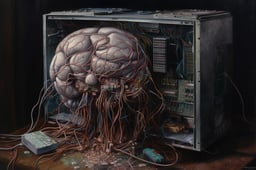Symbolic Artificial Intelligence (AI) is a subfield of AI that focuses on the processing and manipulation of symbols or concepts, rather than numerical data. The goal of Symbolic AI is to build intelligent systems that can reason and think like humans by representing and manipulating knowledge and reasoning based on logical rules.
Symbolic AI Explained
Symbolic AI algorithms work by processing symbols, which represent objects or concepts in the world, and their relationships. The main approach in Symbolic AI is to use logic-based programming, where rules and axioms are used to make inferences and deductions.
Let's say we have a Symbolic AI system that is designed to diagnose medical conditions based on symptoms reported by a patient. The system has a set of rules and axioms that it uses to make inferences and deductions about the patient's condition.
For example, if the patient reports having a fever, the system might use the following rule:
IF patient has a fever AND patient has a cough AND patient has difficulty breathing THEN patient may have pneumonia.
The system would then check if the patient also has a cough and difficulty breathing, and if so, it would conclude that the patient may have pneumonia.
This approach is highly interpretable, as we can easily trace the reasoning process back to the logical rules that were applied. It also allows us to easily modify and update the system's rules as new information becomes available.
Symbolic AI uses formal languages like logic to represent knowledge. This knowledge is processed by reasoning engines that use algorithms to manipulate symbols. This allows for the creation of systems like expert systems and decision support systems that can make deductions and inferences based on predefined rules and knowledge.
Examples of Real-World Symbolic AI Applications
Symbolic AI has been applied in various fields, including natural language processing, expert systems, and robotics. Some specific examples include:
- Siri and other digital assistants use Symbolic AI to understand natural language and provide responses.
- Medical diagnosis systems use Symbolic AI to provide recommendations to doctors based on patient symptoms (as demonstrated earlier).
- Autonomous cars use Symbolic AI to make decisions based on the environment, such as recognizing stop signs and traffic lights.
- Computer vision systems use Symbolic AI to recognize objects and patterns in images.
How Symbolic AI differs from other AI Techniques
Symbolic AI differs from other AI techniques, such as machine learning and deep learning, in that it does not require vast amounts of training data. Instead, Symbolic AI is based on knowledge representation and reasoning, making it more suitable for domains where knowledge is well-defined and can be represented in logical rules.
Machine learning, on the other hand, requires large datasets to learn patterns and make predictions. Deep learning uses neural networks to learn features directly from data, making it suitable for domains with complex and unstructured data.
When to use each technique depends on the problem domain and available data. Symbolic AI is suitable for domains with well-defined and structured knowledge, while machine learning and deep learning are suitable for domains with large amounts of data and complex patterns.
What are the Benefits of Symbolic AI?
Symbolic AI has several advantages, including:
- Interpretability: Symbolic AI provides transparency in the reasoning process, making it easier to understand how a system arrived at a conclusion.
- Knowledge representation: Symbolic AI can represent complex knowledge in a formal and structured way, allowing for easy manipulation and reasoning.
- Flexibility: Symbolic AI is highly flexible and can be adapted to different domains by modifying the rules and knowledge base.
What are the Limitations of Symbolic AI?
Symbolic AI has some limitations, including:
- Incomplete knowledge: Symbolic AI requires complete and well-defined knowledge to function correctly. In domains where knowledge is incomplete, Symbolic AI may not be effective.
- Scalability: Symbolic AI can become computationally expensive as the number of symbols and rules increases, making it difficult to scale to large domains.
- Difficulty with handling uncertain or ambiguous information: Symbolic AI relies on precise and unambiguous representations of knowledge, limiting its ability to reason effectively with uncertain or ambiguous data.
- Limited ability to learn and adapt: Symbolic AI systems require manual programming and may not allow for real-time learning and adaptation.
Want to learn more about AI? Check out the following resources:
FAQs
What is the difference between Symbolic AI and machine learning?
Symbolic AI is based on knowledge representation and reasoning, while machine learning learns patterns directly from data.
What is an expert system?
An expert system is a type of Symbolic AI system that uses a knowledge base and a set of rules to provide recommendations or solutions to problems.
Can Symbolic AI be combined with other AI techniques?
Yes, Symbolic AI can be combined with other AI techniques, such as Machine Learning and Deep Learning, to create hybrid models that leverage the strengths of each approach. For example, a system that uses Symbolic AI for knowledge representation and reasoning, and Machine Learning for pattern recognition, can achieve better performance than either approach alone.
What kind of problems is Symbolic AI best suited to solve?
Symbolic AI is best suited for problems that require logical reasoning, rule-based decision making, and expert knowledge. Examples include diagnosis and treatment planning in medicine, scheduling and resource allocation in manufacturing, and fraud detection in finance.
What are some current research topics in Symbolic AI?
Some current research topics in Symbolic AI include explainable AI, which aims to create AI systems that can explain their reasoning to humans, cognitive computing, which seeks to create AI systems that can mimic human cognition, and commonsense reasoning, which focuses on creating AI systems that can reason about everyday situations and common sense knowledge.
How do I get started with Symbolic AI?
To get started with Symbolic AI, you can begin by learning about knowledge representation and reasoning, logic programming, and expert systems. There are also many open-source and commercial tools available for developing Symbolic AI applications, such as Prolog, CLIPS, and Drools.


